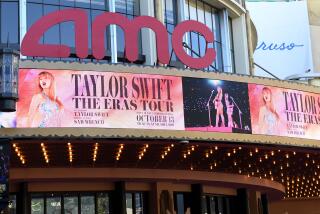Rotten Tomatoes tweaks audience ratings system to thwart online trolls
- Share via
Walt Disney Co.’s “Captain Marvel” is expected to open with a spectacular $100 million in ticket sales from the U.S. and Canada alone next month.
And yet, according to the highly influential website Rotten Tomatoes, only 28% of moviegoers are interested in seeing Marvel Studios’ first superhero film with a solo female lead. What gives?
Blame online trolls, who have previously waged campaigns to lower audience ratings for movies including “Star Wars: The Last Jedi” and “Ghostbusters” by flooding their pages with negative, sometimes sexist comments. Such “review bombing” efforts are a serious problem for Rotten Tomatoes, which depends on credible ratings to drive traffic to its free website.
The company, owned by the largest online movie ticket seller, Fandango, now has a plan to curb the abuse.
In a major change, Rotten Tomatoes will no longer allow users to post audience reviews before a film hits theaters, the Beverly Hills company told The Times on Monday. Users will now have to wait until a movie’s actual release to review and rate a film. The company is also changing the way it polls moviegoers about whether they want to see a film.
The moves are part of a broader effort to make the audience-rating system more trustworthy and useful to readers, Fandango President Paul Yanover said.
“We said, ‘Why are we turning this into a blog where we have people debating one another about a movie they haven’t seen?’ ” Yanover said in a phone interview. “There’s not enough value to continue doing it.”
Rotten Tomatoes is best known for its Tomatometer, which bestows movies with bright red tomato icons and ugly green splats, depending on how many professional critics wrote positive reviews. The ratings have a considerable influence on box office, causing anxiety among studio executives. They have also been controversial. Last year, the company changed its criteria for approving critics included in its ratings system, responding to complaints that the site was dominated by reviews from white men.
The site’s Yelp-like audience scores usually get less attention than the dreaded Tomatometer. But they still have sway, according to executives. When at least 60% of users rate a movie at 3.5 stars or more, the film gets a red popcorn bucket icon. Those that don’t meet that threshold get a green bucket tipped over on its side.
Rotten Tomatoes wants to raise the profile of its user ratings. Lately, though, the audience scores have entered the limelight for all the wrong reasons.
In 2017, trolls preemptively bombarded Rotten Tomatoes and IMDB with negative reactions to “Star Wars: The Last Jedi,” balking at the Lucasfilm series’ more inclusive direction. Racist and sexist fan culture drove “Last Jedi” star Kelly Marie Tran, who is Asian American, to leave Instagram. The all-female 2016 “Ghostbusters” reboot was also slammed by users on the site.
Rotten Tomatoes is trying to counteract the problem by changing how it reflects moviegoers’ interest in upcoming films. Previously, pre-release sentiment was indicated as a percentage showing what portion of users said they wanted to see a movie, a system that was vulnerable to abuse. Rotten Tomatoes will now showcase consumer interest with a raw number, similar to how Facebook counts “likes.”
Additionally, the company is considering ways to verify user comments based on whether they bought tickets for the movie on Fandango or how often they post reviews on Rotten Tomatoes. It’s also exploring ways to help users see more personalized scores for movies.
“It’s not our business to control opinion,” Yanover said. “People are going to love and hate different products for different reasons. Security and relevancy are major threads to create usefulness.”
More to Read
Inside the business of entertainment
The Wide Shot brings you news, analysis and insights on everything from streaming wars to production — and what it all means for the future.
You may occasionally receive promotional content from the Los Angeles Times.











